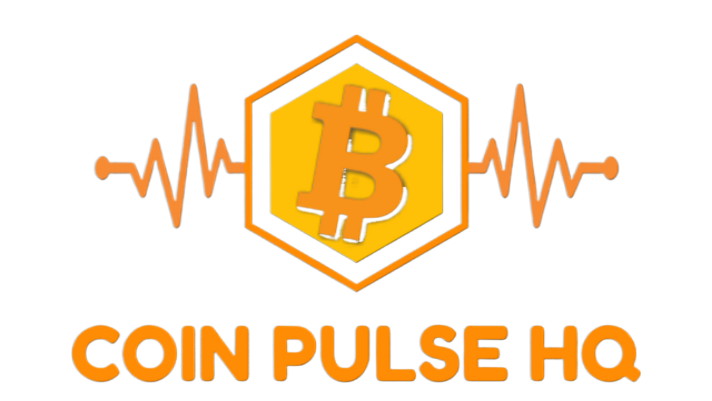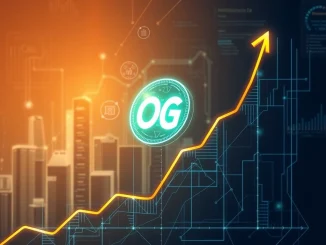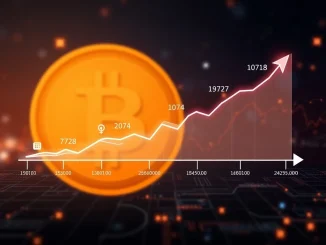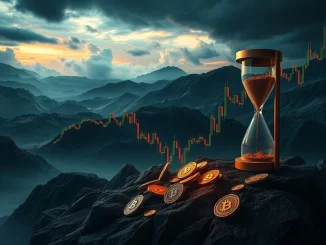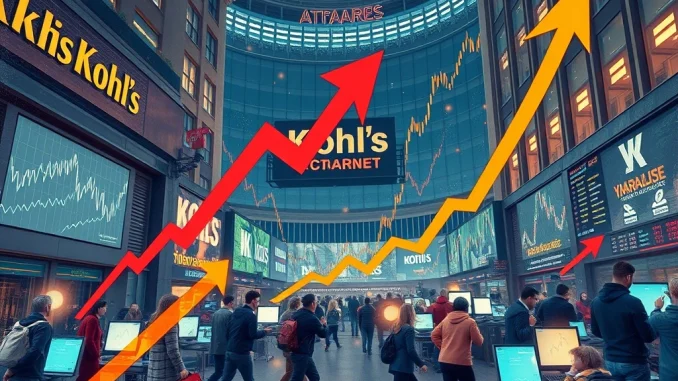
For anyone familiar with the exhilarating highs and sudden drops of the cryptocurrency market, the recent surge in Kohl’s shares might feel remarkably familiar. Just like digital assets can experience parabolic pumps driven by community sentiment, traditional stocks are increasingly falling prey to the collective power of meme stock rallies. Kohl’s, a long-standing retail giant, recently became the latest battleground, witnessing an astonishing 105% surge that sent shockwaves through the financial world, largely orchestrated by a new breed of influential retail traders.
Understanding the Meme Stock Phenomenon
The term ‘meme stock’ exploded into the mainstream during the GameStop frenzy of early 2021, and it refers to shares of a company that gain immense popularity among online communities, particularly on social media platforms like Reddit’s r/WallStreetBets. Unlike traditional investments driven by fundamental analysis, meme stocks are propelled by:
- Social Media Hype: Coordinated buying efforts fueled by viral discussions and a shared sense of purpose among individual investors.
- High Short Interest: Often, these stocks are heavily shorted by institutional investors, making them prime targets for a short squeeze.
- Weak Fundamentals: Paradoxically, many meme stocks belong to companies with struggling business models, making their rallies purely speculative.
- Volatile Price Action: Extreme price swings, rapid surges, and equally swift corrections are hallmarks of this phenomenon.
Kohl’s perfectly fit this mold, transforming from a traditional department store chain struggling with declining sales into a symbol of defiance against institutional short sellers. The surge demonstrated how quickly market dynamics can shift when a large, decentralized group of investors decides to act in concert, creating unprecedented stock market volatility.
Kohl’s Unprecedented Surge and Volatility
On July 2, 2025, Kohl’s Corp. (KSS) shares soared by an incredible 105% in early trading, triggering multiple market halts due to extreme volatility. While the stock eventually settled with a still remarkable 39% gain for the day, this single event marked Kohl’s largest one-day jump in its history. This meteoric rise wasn’t driven by a sudden improvement in the company’s financials or a strategic acquisition; it was a classic meme stock rally, fueled by retail investors betting on a massive short squeeze.
Over the subsequent weeks, the stock continued its rollercoaster ride, peaking with a near-40% increase on June 30 and a 25% rise on July 1 as social media buzz intensified. However, as is typical with such speculative surges, shares retreated to pre-rally levels by late July, underscoring the ephemeral nature of these movements. This pattern highlights the inherent risks for retail traders chasing quick gains, as sentiment can shift dramatically, leading to significant losses for those caught on the wrong side of the trade.
The Allure of a Short Squeeze
At the heart of many meme stock rallies lies the concept of a short squeeze. To understand this, consider the following:
- Short Selling: Institutional investors often ‘short’ a stock when they believe its price will fall. They borrow shares, sell them, and hope to buy them back later at a lower price to return them, profiting from the difference.
- High Short Interest: If a large percentage of a company’s shares are shorted, it means many big players are betting against the stock.
- The Squeeze: When retail traders coordinate to buy up these heavily shorted shares, the price begins to rise. As the price increases, short sellers face mounting losses and are forced to buy back shares to cover their positions (to limit their losses), which further drives up the price – creating a ‘squeeze.’
Kohl’s, despite its weak fundamentals and declining sales, became an attractive target due to its significant short interest. For many retail traders, this wasn’t just about making money; it was a perceived battle against institutional investors, a challenge to the traditional Wall Street establishment. This collective psychological drive often outweighs any logical financial analysis, leading to extreme stock market volatility.
Risks and Rewards for Retail Traders
While the prospect of doubling one’s investment in a single day is undeniably tempting, participating in meme stock rallies comes with substantial risks, particularly for individual retail traders:
- Extreme Volatility: Prices can surge and plummet within hours, making it difficult to enter or exit positions profitably.
- Lack of Fundamentals: Without underlying business strength, these rallies are unsustainable. Once the social media buzz fades, the stock often reverts to its true value.
- Timing is Everything: Most participants arrive late to the party, buying at the peak and suffering significant losses when the inevitable correction occurs. Kohl’s, for instance, lost nearly half its post-rally value by late July.
- Information Asymmetry: While retail traders coordinate, institutional players have access to faster data and more sophisticated trading tools.
Conversely, the rewards, though fleeting, can be immense for those who time it right. The allure lies in the democratization of finance, allowing individual investors to collectively challenge powerful institutions and potentially achieve life-changing gains, even if only for a brief period.
Broader Market Implications and Regulatory Scrutiny
The Kohl’s episode, much like GameStop and Bed Bath & Beyond before it, highlights the growing influence of retail traders in shaping stock prices, even for well-established companies. This trend has several broader implications:
- Market Efficiency Debates: It challenges the traditional view of efficient markets, where prices reflect all available information, by demonstrating how sentiment and coordinated action can temporarily override fundamentals.
- Regulatory Challenges: The decentralized nature of these trading communities poses significant challenges for regulators. How do you monitor and regulate coordinated buying efforts that aren’t traditional market manipulation?
- Increased Stock Market Volatility: The rise of meme stocks contributes to overall market instability, creating unpredictable swings that can impact broader indices.
- Shifting Power Dynamics: It signals a shift in power, where individual investors, once considered insignificant, can now collectively move multi-billion dollar companies.
The cyclical nature of meme stock activity suggests that Kohl’s won’t be the last company to experience such a ride. As long as there are heavily shorted stocks and active online communities, the potential for another dramatic surge, driven by the collective will of retail traders and the mechanics of a short squeeze, remains a significant factor in today’s financial landscape.
Conclusion: The Enduring Power of the Crowd
The incredible 105% surge in Kohl’s shares serves as a potent reminder of the transformative, and often unpredictable, power of collective action in financial markets. While Kohl’s underlying fundamentals remain challenging, its brief stint as a meme stock sensation vividly illustrates how retail traders, armed with social media and a shared purpose, can ignite unprecedented stock market volatility and trigger a massive short squeeze. This phenomenon is a double-edged sword: offering tantalizing opportunities for quick gains, but also posing significant risks for those who misjudge the fickle nature of online sentiment. As markets continue to evolve, understanding the psychology and mechanics behind these crowd-driven surges will be crucial for all participants, from seasoned institutions to individual investors navigating the new frontier of digital finance.
Frequently Asked Questions (FAQs)
What is a meme stock?
A meme stock is a stock that gains significant popularity and experiences rapid, often volatile, price movements driven primarily by social media buzz and coordinated buying by individual investors (retail traders), rather than by the company’s underlying financial performance or traditional market analysis. These stocks often have high short interest, making them targets for a short squeeze.
How do retail traders influence meme stock rallies?
Retail traders influence meme stock rallies by coordinating their buying efforts through online forums and social media platforms like Reddit’s r/WallStreetBets. Their collective buying power, especially when focused on heavily shorted stocks, can create significant upward price pressure, forcing institutional short sellers to cover their positions, which further amplifies the rally.
What is a short squeeze and why is it important for meme stocks?
A short squeeze occurs when the price of a stock that has been heavily shorted suddenly rises, forcing short sellers to buy back shares to limit their losses. This buying activity further pushes up the price, creating a rapid upward spiral. For meme stocks, a high short interest makes them attractive targets for retail traders who aim to trigger a short squeeze, challenging institutional investors betting against the company.
What are the risks associated with investing in meme stocks?
Investing in meme stocks carries significant risks due to their extreme volatility. Prices can surge dramatically and then plummet just as quickly, leading to substantial losses for investors who buy at the peak. These rallies are often not supported by strong company fundamentals, making them highly speculative and susceptible to rapid corrections once retail enthusiasm wanes.
How does the Kohl’s meme stock rally compare to GameStop or Bed Bath & Beyond?
The Kohl’s meme stock rally is very similar to those seen with GameStop and Bed Bath & Beyond. All three involved companies with struggling fundamentals and high short interest, making them prime targets for coordinated buying by retail traders on social media platforms. The pattern typically includes a massive, rapid surge in price followed by a sharp correction, driven by speculative sentiment rather than business performance.
Are meme stock rallies sustainable long-term?
Generally, meme stock rallies are not sustainable long-term. They are driven by speculative sentiment, social media hype, and short squeezes, rather than by a company’s improving financial health or strategic growth. Once the retail enthusiasm fades or short positions are covered, the stock price tends to revert to levels more reflective of its underlying business fundamentals, often leading to significant declines from their peaks.
